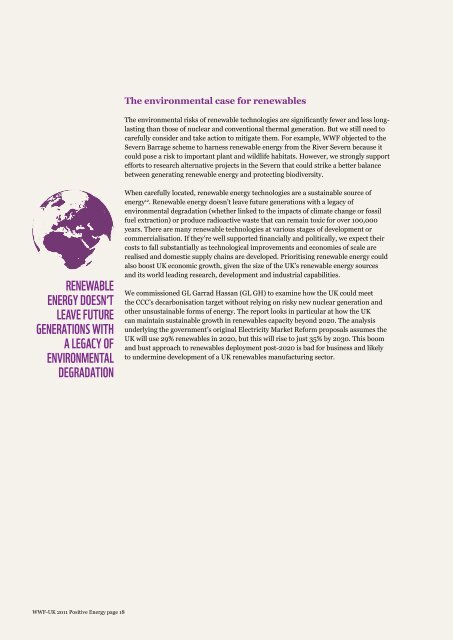Positive Energy: how renewable electricity can transform ... - WWF UK
Positive Energy: how renewable electricity can transform ... - WWF UK
Positive Energy: how renewable electricity can transform ... - WWF UK
You also want an ePaper? Increase the reach of your titles
YUMPU automatically turns print PDFs into web optimized ePapers that Google loves.
The environmental case for <strong>renewable</strong>s<br />
The environmental risks of <strong>renewable</strong> technologies are signifi<strong>can</strong>tly fewer and less longlasting<br />
than those of nuclear and conventional thermal generation. But we still need to<br />
carefully consider and take action to mitigate them. For example, <strong>WWF</strong> objected to the<br />
Severn Barrage scheme to harness <strong>renewable</strong> energy from the River Severn because it<br />
could pose a risk to important plant and wildlife habitats. However, we strongly support<br />
efforts to research alternative projects in the Severn that could strike a better balance<br />
between generating <strong>renewable</strong> energy and protecting biodiversity.<br />
Renewable<br />
energy doesn’t<br />
leave future<br />
generations with<br />
a legacy of<br />
environmental<br />
degradation<br />
When carefully located, <strong>renewable</strong> energy technologies are a sustainable source of<br />
energy 12 . Renewable energy doesn’t leave future generations with a legacy of<br />
environmental degradation (whether linked to the impacts of climate change or fossil<br />
fuel extraction) or produce radioactive waste that <strong>can</strong> remain toxic for over 100,000<br />
years. There are many <strong>renewable</strong> technologies at various stages of development or<br />
commercialisation. If they’re well supported financially and politically, we expect their<br />
costs to fall substantially as technological improvements and economies of scale are<br />
realised and domestic supply chains are developed. Prioritising <strong>renewable</strong> energy could<br />
also boost <strong>UK</strong> economic growth, given the size of the <strong>UK</strong>’s <strong>renewable</strong> energy sources<br />
and its world leading research, development and industrial capabilities.<br />
We commissioned GL Garrad Hassan (GL GH) to examine <strong>how</strong> the <strong>UK</strong> could meet<br />
the CCC’s decarbonisation target without relying on risky new nuclear generation and<br />
other unsustainable forms of energy. The report looks in particular at <strong>how</strong> the <strong>UK</strong><br />
<strong>can</strong> maintain sustainable growth in <strong>renewable</strong>s capacity beyond 2020. The analysis<br />
underlying the government’s original Electricity Market Reform proposals assumes the<br />
<strong>UK</strong> will use 29% <strong>renewable</strong>s in 2020, but this will rise to just 35% by 2030. This boom<br />
and bust approach to <strong>renewable</strong>s deployment post-2020 is bad for business and likely<br />
to undermine development of a <strong>UK</strong> <strong>renewable</strong>s manufacturing sector.<br />
<strong>WWF</strong>-<strong>UK</strong> 2011 <strong>Positive</strong> <strong>Energy</strong> page 18

















